Dinosaurs
What are dinosaurs?
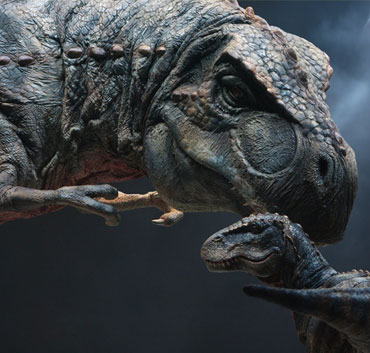
Dinosaurs are the largest animals that have ever lived on land. They roamed the Earth for about 160 million years, but died out 65 million years ago. The first people did not appear on Earth for another 64 million years and have, so far, lived for only a fraction of the time that dinosaurs did.
Scientists knowledge of dinosaurs comes mainly from the study of fossils - hardened remains of plants or animals preserved in rock.
The history of Earth, since it began about 4,500 million years ago, is divided into eras. The age of of the dinosaurs spans most of the Mesozoic, or middle, era. This era is itself divided into three periods - the Triassic (256-208 million years ago), the Jurrasic (208-146 million years ago) and the Crettaceous (146-65 million years ago)(see Geological Time).
Reptiles already existed on Earth before dinosaurs appeared. During the early part of the Triassic period many new kinds were evolving, such as the fast-running cynodont ("dog-toothed") reptiles, which preyed on slow-moving herds of plant-eaters. Most early reptiles held their legs out at an angle from the sides of their bodies, much like today's lizards.
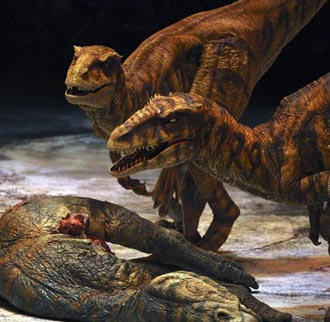
Eventually these were replaced by archosaurs ("ruling reptiles"). One group had a different body shape and could hold their legs directly below their bodies. This seems to have been the start of the successful body design found in their descendants, the dinosaurs ("terrible lizards").
By the end of the Triassic period, the first true dinosaurs roamed the world. But the dinosaurs' heyday was during the Cretaceous period, when the greatest number and variety were found. Over 1,000 species of dinosaurs have been recorded so far. These can be divided into two dinstinct groups: herbivores (plant-eaters) and carnivores (meat-eaters).
Of all the dinosaurs that have been discovered, the most popular ones are explored in more detail below.
Brachiosaurus
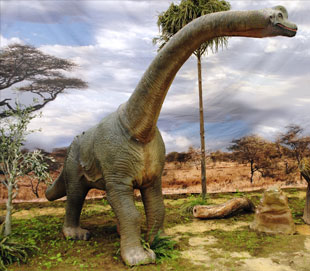
The largest dinosaur was Brachiosaurus. It was nearly 24 m (79 ft) long and its head reached 17 m (56 ft) above the ground to munch the leaves on which it fed. It could have looked over the top of a house and if it had stood in the gardens, its tail would have been four houses away from its nose.
Brachiosaurus would certainly have crushed a few flowers. It weighed up to 51 tonnes, as heavy as 250 Sumo wrestlers.
Brachiosaurus walked on four legs and, like the other Brachiosaurids and unlike most dinosaurs, its front legs were longer than its hind legs.
Diplodocus
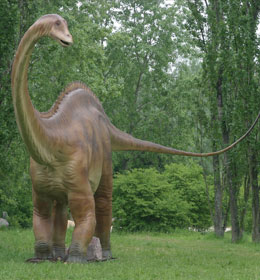
Diplodocus was even longer than Brachiosaurus. It measured 27 m (89 ft) from the tip of its nose to the end of its tail, nearly as long as three buses, bumper to bumper. Its nostrils were at the top of its head and it had peg-like teeth, but only in the front of the jaws. Its front legs were shorter than its back legs.
Diplodocus's tail was so far from it's brain that a human could have stood on it's tail and run away before the message reached the dinsosaur's brain. Diplodocus had such a small brain in its head that scientists think that it may have had a second brain down its spine to control the back part of its body.
Diplodocus was more lightly built than the other giant sauropods, and may have weighed only about 10-20 tons.
Pachycephalosaurus
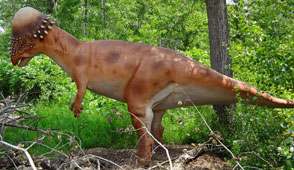
Pachycephalosaurus was a bone headed dinosaur. It possessed a thick domed skull cap, suitable for butting heads with competing males.
Pachycephalosaurus walked on two legs, had 5 fingered hands, 3 toed feet, and had a long heavy tail.
Pachycephalosaurus roamed in herds across parts of North America and Central Asia.
Pinacosaurus
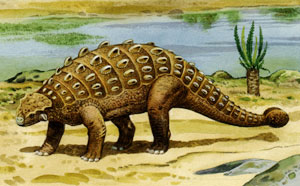
Pinacosaurus was medium-sized, armored, beaked, quadruped with a slender build. It had a tail club, bony spikes along its back and tail, but didn't have armor on its snout. Pinacosaurus had flared nostrils, four large hoof-covered toes on its front feet and five toes on each of its rear feet.
Pinacosaurus stunned its attackers by hitting them with the bony club on its tail.
Pterodactyl
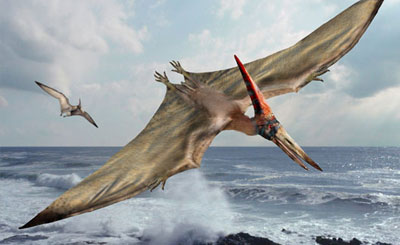
Pterodactyl was a small, flying reptile that lived during the time of the dinosaurs. It was not a dinosaur, but type of extinct, flying reptile.
Pterodactylus had a 0.75 to 1 m (2.5 to 3.1 ft) wide wingspan. It was lightly built, with hollow bones, a long, curved neck, a long skull (with no crest), a long, pointed beak, many small teeth, a small body, and a very short tail. It had a relatively large brain and good eyesight. The skull was about 2.4 inches (6 cm) long.
Pterodactyloid wings were covered by a leathery membrane. This thin but tough membrane stretched between its body, the top of its legs and its elongated fourth fingers, forming the structure of the wing. Claws protruded from the other fingers. Pterodactylus could flap its wings and fly with power.
Stegosaurus
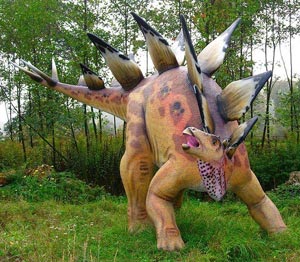
Stegosaurus was up to 8 to 9 m (26 to 30 ft) long, about 2.75 m (9 ft) tall, and weighed about 6,800 pounds (3100 kg). Its small brain was only the size of a walnut (weighing roughly 2.5 - 2.9 ounces (70 - 80 grams).
Its skull was long. Pointed, and narrow, it had a toothless beak and small cheek teeth. Its head was carried close to the ground, probably no more than 1 m (3 ft) high.
Stegosaurus had 17 bony plates that were embedded in its back. The plates were probably well-nourished by blood vessels, indicating that the plates may have been used to regulate the dinosaur's temperature. They may have also been used for protection or mating display purposes.
Triceratops
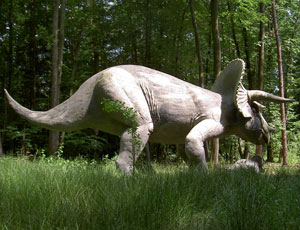
Triceratops was a rhinoceros-like dinosaur. It walked on four sturdy legs and had three horns on its face along with a large bony plate projecting from the back of its skull (a frill). One short horn above its parrot-like beak and two longer horns over 1 m (3 ft) long above its eyes probably provided protection from predators. The horns were possibly used in mating rivalry and rituals.
It had a large skull, up to 3 m (10 ft) long, one of the largest skulls of any land animal ever discovered. Its head was nearly one-third as long as its body. Triceratops hatched from eggs.
Tyrannosaurus Rex

Tyrannosaurus Rex was the largest meat-eating dinosaur. It was 16 m (52 ft) long and stood up to 6 m (20 ft) high. Its huge jaws were full of dagger-like teeths 15 cm (6 in) long.
A Tyrannosaurus Rex may not have been as ferocious as it looked. Its front legs were so small and weak, it would not have been much of a fighter. It most likely preyed on old or weak dinosaurs, or scavenged the left-overs of other dinosaurs' prey. Scientists believe this powerful predator could eat up to 500 pounds (230 kg) of meat in one bite. Fossils of T. rex prey, including Triceratops and Edmontosaurus, suggest T. rex crushed and broke bones as it ate, and broken bones have been found in its dung.
When a T-Rex ran, it could go 32 km/hr (40 mph) and could cover 4.5 m (15 ft) in one step.
Velociraptor
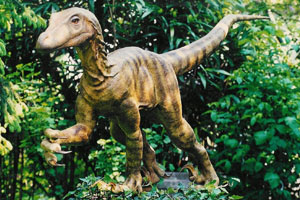
A Velociraptor was a small dinosaur, but a highly efficient killer. They had a sharp, deadly, sickle-shaped, retractible, 3.5 inch (9 cm) long claw on each foot (located on each second toe).
Velociraptors may have been able to run up to roughly 60 km/hr (40 mph) for short bursts.
Velociraptor probably hunted in packs, like modern dogs, as this would have allowed them to tackle prey considerably larger than them.
Fossils

People have been finding fossils of dinosaur bones for hundreds of years, although they have not always known what they were - some thought they were the bones of human giants? It was only in the 1829's that people began to realize they were the remains of giant reptiles, now extinct.
The most common fossils are bones and teeth, the hard parts of the animal that resist the processes of decomposition. The second most common fossils are footprints.
Coprolites (fossilized dinosaur droppings) can be dissected, along with gut contents and stomach stones, to reveal details of diet.
Although impressions of dinosaur skins have been found, nobody knows what colour dinosaurs were, as skin decomposes too quickly to fossilize.
How did dinosaurs become extinct?
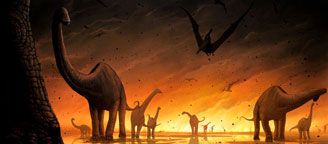
At the end of the Cretaceous period, about 65 million years ago, the dinosaurs became extinct. Palaeontologists have been unable to give a completely satisfactory explanation for this, but there are several theories.
One suggests that a star exploded close to Earth and covered the planet in deadly radiation.

Evidence of an enormous underground crater in the Northern Arizona desert of the United States, suggests that a giant meteorite collided with Earth, causing a huge explosion. This in turn caused a thick blanket of dust to form in the atmosphere, blotting out the sun for several months and causing complete distruption to life on Earth.
Other scientists believe the dinosaurs died out as a result of a gradual climatic change. Winters became colder, or summers hotter, favouring the survival of small land mammals which were able to hibernate. We will probably never know for sure.